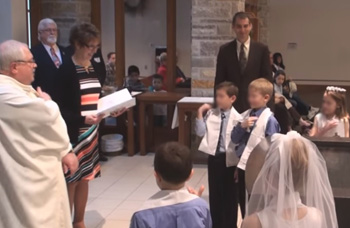Adopting a Protestant-Inspired Rite
Dr. Carol Byrne, Great Britain
It is noteworthy that, before 1956, the Renewal of Baptismal Promises was never part of the official liturgy of the Roman Rite, but only a semi-private “para-liturgy” conducted among special groups in retreats, missions, anniversaries of one’s Baptism and at the First Communion of children. An important factor is that these ceremonies were introduced on the initiative of individual pastors at the local level. Not all of them were performed in church. There was no set formula of words. And as their occurrence was only sporadic, they did not constitute anything approaching a universal custom.

The heretic Erasmus first proposed the renewal of baptismal vows
Historically, the Catholic Church had always discouraged attempts to give the Renewal of Baptismal Promises a place in the liturgy. One brief but indicative example was when Erasmus proposed a ritual in 1522 for adolescents to renew their baptismal vows; his suggestion was censored by the foremost Scholastic theologian of the day, Noël Beda, (1) and his book placed on the Index by Pope Paul IV in 1559. (2)
It was, therefore, a major innovation when Pius XII, acting at the behest of his 1948 Commission, (3) suddenly imposed the rite by force majeure on the whole Church in 1956. It was also something of a coup for the Liturgical Movement, which had been agitating for its inclusion in the liturgy. (4)
Only one of the consultors of the papal Commission, however, had misgivings about the appropriateness of this rite in the Easter Vigil. Dom Bernard Capelle, to grant him his due, was opposed to this reform and expressed his disagreement in forceful terms:
- Its introduction was unnecessary (“nulla habetur necessitas”);
- It gave primacy to the theme of Baptism over the Resurrection, thus compromising the theological meaning of the Vigil;
- It was a total novelty (“ex toto novorum”) lacking any historical claim to liturgical usage;
- It should not be used at the Easter Vigil as a substitute for Baptism. (5)
A rite inspired by Protestantism
As a liturgical rite, the Renewal of Baptismal Promises emerged from the “Reformation”; it was first recorded in the 1662 Book of Common Prayer (6) as part of the Protestant “confirmation” rite. (7)
The ritual is conducted in both the Protestant and revised Catholic liturgies on similar lines. The Bishop or priest faces the people, gives a short address and conducts a “dialogue” in the vernacular with the whole congregation. It is not surprising, therefore, that this ceremony, alien to any Catholic concept of the lex credendi would clash egregiously with the lex orandi. This is glaringly obvious both in its outward form and in its ambiguous theological import.
This was the first time in the History of the Church that a ceremony of Protestant inspiration and ethos was officially incorporated into the liturgy, but, as the Novus Ordo, would amply demonstrate, it was not the last.
Muddying the waters of Baptism
Fr. Antonelli explained that the Renewal was among those practices “to be restored if their reintroduction would truly render the rites more pure and more intelligible to the minds of the faithful.” (8) But, how intelligible is it? And what exactly is renewed?

In a recent First Communion class children are taught to renew their baptismal vows
It makes sense to recall our baptismal vows, to ponder how far we have fallen short of them, as the Catechism of the Council of Trent recommended, (9) to reaffirm our adherence to the Faith, and to renew our efforts to progress in the spiritual life with the aid of the Mass and the Sacraments.
That much is crystal clear. What is not so clear is the term “Renewal” of Baptismal Promises. It may be interpreted in the traditional sense outlined above, but it is potentially dangerous in its lack of precision, rendering it unsuitable for inclusion in the liturgy. For, Baptism is the renewal, whereby one goes into the church unbaptized and comes out a Christian. One can never be in that unique position again and, although baptismal grace can be lost, the force of the original vows remains unchanged. They cannot, therefore, be said to stand in need of renewal.
In the next instalment, we shall see how the new ritual further destabilized the Easter Vigil by changing its theological focus from Christ to the people, all for the sake of their “active participation.”
To be continued
- Noël Beda was head of the Theology Faculty in Paris and used Scholastic theology to defend the Faith against the errors of the nascent Protestant “Reformation.” Erasmus, on the other hand, had little regard for precision in religious matters and held Scholasticism in contempt.
- The book, entitled Parafrasi sopra S. Matteo (Paraphrase on St Matthew’s Gospel), was specifically named in the Index. See here, p. 132
- In 1948, the Commission included in its “Memo”, n. 74, a proposal for the Renewal of Baptismal Promises to be elaborated by a sub-commission and submitted to the Pope for his approval.
- As early as the 1920s, Dom Virgil Michel, O.S.B., reputedly the “father of the Liturgical Movement in the USA, had designed a ritual for the Renewal of Baptismal Promises, which he described in ‘Baptism Consciousness,’ Orate Fratres, 1, 1927, pp. 309-313; Dom Godfrey Diekmann, O.S.B., further promoted the ceremony during the First National Liturgical Week at Chicago 1940.
- B. Capelle, Memoria, Supplemento II, 1950, pp. 21-22.
- Paul F. Bradshaw, New SCM Dictionary of Liturgy and Worship, SCM Press, 2002, p. 52.
- The 16th century Protestants had refused to recognize Confirmation as a Sacrament, and their followers devised the Renewal of Baptismal Promises for their own “confirmation” ceremony. Vatican II ordered this to be adopted in the Catholic Church. Sacrosanctum Concilium stated: “The rite of confirmation is also to be revised in order that the intimate connection of this sacrament with the whole of Christian initiation may stand out more clearly; for this reason it is fitting for candidates to renew their baptismal promises just before they are confirmed.” (SC, § 71)
- Memoria sulla reforma liturgica: Supplemento II – Annotazioni alla “Memoria”, n. 76, 1950, p. 9.
- The Catechism of the Council of Trent reassured priests administering Baptism that the faithful would be edified by witnessing the rite: “Thus each person, reading a lesson of admonition in the person of him who is receiving Baptism, calls to mind the promises by which he had bound himself to the service of God when initiated by baptism, and reflects whether his life and morals evince that fidelity to which every one pledges himself, by professing the name of Christian.” (Baltimore, 1829, p. 113)

This was said in 1965...no wonder we are in the shape we are in now. Definitely Vatican II thinking and dismantling of the True Catholic Church!
ReplyDelete